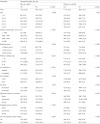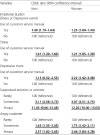2. Harma M, Kompier MA, Vahtera J. Work-related stress and health--risks, mechanisms and countermeasures. Scand J Work Environ Health. 2006; 32(6):413–419. Epub 2006/12/19. PubMed PMID: 17173198.

3. Hochschild A. The managed heart: commercialization of human feeling. Berkeley, CA: University of California Press; 1983.
4. Welsh D. Predictors of depressive symptoms in female medical-surgical hospital nurses. Issues Ment Health Nurs. 2009; 30(5):320–326.

5. Mikkelsen A, Ogaard T, Landsbergis P. The effects of new dimensions of psychological job demands and job control on active learning and occupational health. Work & Stress. 2005; 19(2):153–175. DOI:
10.1080/02678370500167808.

6. Siu C, Yuen SK, Cheung A. Burnout among public doctors in Hong Kong: cross-sectional survey. Hong Kong Med J 2012;18(3):186–192. Epub 2012/06/06. PubMed PMID: 22665681.
7. Maslach C, Schaufeli WB, Leiter MP. Job burnout. Annu Rev Psychol 2001;52:397–422. Epub 2001/01/10. 10.1146/annurev.psych.52.1.397. PubMed PMID: 11148311.
8. Yoon SL, Kim JH. Job-related stress, emotional labor, and depressive symptoms among Korean nurses. J Nurs Scholarsh 2013;45(2):169–176. Epub 2013/03/09. 10.1111/jnu.12018. PubMed PMID: 23470274.
9. Morris JA, Feldman DC. The dimensions, antecedents, and consequences of emotional labor. Acad Manag Rev. 1996; 21(4):986–1010. DOI:
10.5465/amr.1996.9704071861.

10. Zapf D, Holz M. On the positive and negative effects of emotion work in organizations. European J Work Organ Psychol. 2007; 15(1):1–28. DOI:
10.1080/13594320500412199.

11. Zapf D, Seifert C, Schmutte B, Mertini H, Holz M. Emotion work and job stressors and their effects on burnout. Psychol Health 2001;16(5):527–545. Epub 2001/09/01. 10.1080/08870440108405525. PubMed PMID: 22804497.
12. Lewig KA, Dollard MF. Emotional dissonance, emotional exhaustion and job satisfaction in call Centre workers. European J Work Organ Psychol. 2010; 12(4):366–392. DOI:
10.1080/13594320344000200.

13. Demerouti E, Bakker AB, de Jonge J, Janssen PP, Schaufeli WB. Burnout and engagement at work as a function of demands and control. Scand J Work Environ Health 2001;27(4):279–286. Epub 2001/09/19. PubMed PMID: 11560342.
14. Yoon JH, Jeung D, Chang SJ. Does high emotional demand with low job control relate to suicidal ideation among service and sales Workers in Korea? J Korean Med Sci 2016;31(7):1042–1048. Epub 2016/07/02. 10.3346/jkms.2016.31.7.1042. PubMed PMID: 27366000; PubMed Central PMCID: PMCPMC4900994.
15. Lynch TR, Cheavens JS, Morse JQ, Rosenthal MZ. A model predicting suicidal ideation and hopelessness in depressed older adults: the impact of emotion inhibition and affect intensity. Aging Ment Health 2004;8(6):486–497. Epub 2005/02/24. doi: 10.1080/13607860412331303775. PubMed PMID: 15724830.
16. Chapman BP, Fiscella K, Kawachi I, Duberstein P, Muennig P. Emotion suppression and mortality risk over a 12-year follow-up. J Psychosom Res 2013;75(4):381–385. Epub 2013/10/15. 10.1016/j.jpsychores.2013.07.014. PubMed PMID: 24119947; PubMed Central PMCID: PMCPMC3939772.
17. de Castro AB, Agnew J, Fitzgerald ST. Emotional labor: relevant theory for occupational health practice in post-industrial America. AAOHN J 2004;52(3):109–115. Epub 2004/04/08. PubMed PMID: 15068101.
18. Ashforth BE, Humphrey RH. Emotional labor in service roles: the influence of identity. Acad Manag Rev. 1993; 18(1):88–115. DOI:
10.5465/amr.1993.3997508.

19. Totterdell P, Holman D. Emotion regulation in customer service roles: testing a model of emotional labor. J Occup Health Psychol 2003;8(1):55–73. Epub 2003/01/30. PubMed PMID: 12553529.
20. Grandey A, Foo SC, Groth M, Goodwin RE. Free to be you and me: a climate of authenticity alleviates burnout from emotional labor. J Occup Health Psychol 2012;17(1):1–14. Epub 2011/08/31. 10.1037/a0025102. PubMed PMID: 21875210.
21. Schmidt KH, Diestel S. Differential effects of decision latitude and control on the job demands-strain relationship: a cross-sectional survey study among elderly care nursing staff. Int J Nurs Stud 2011;48(3):307–317. Epub 2010/05/18. 10.1016/j.ijnurstu.2010.04.003. PubMed PMID: 20472236.
22. Gross JJ, Levenson RW. Hiding feelings: the acute effects of inhibiting negative and positive emotion. J Abnorm Psychol 1997;106(1):95–103. Epub 1997/02/01. PubMed PMID: 9103721.
23. Iacovides A, Fountoulakis KN, Kaprinis S, Kaprinis G. The relationship between job stress, burnout and clinical depression. J Affect Disord 2003;75(3):209–221. Epub 2003/07/26. PubMed PMID: 12880934.
24. Bianchi R, Schonfeld IS, Laurent E. Is it time to consider the "burnout syndrome" a distinct illness? Front Public Health 2015;3:158. Epub 2015/06/25. 10.3389/fpubh.2015.00158. PubMed PMID: 26106593; PubMed Central PMCID: PMCPMC4459038.
25. Indregard AR, Knardahl S, Nielsen MB. Emotional dissonance and sickness absence: a prospective study of employees working with clients. Int Arch Occup Environ Health 2017;90(1):83–92. Epub 2016/11/01. 10.1007/s00420-016-1176-9. PubMed PMID: 27796505.
26. Grandey A, Dickter D, Sin H. The customer is not always right: customer aggression and emotion regulation of service employees. J Organ Behav. 2004;25.
28. Castanheira Facio B, Chambel MJ. JD-C model to explain burnout in frontline workers: the useful contribution of emotional demands. Human Fact Ergon Manuf Ser Indust. 2013; 23(5):412–423. DOI:
10.1002/hfm.20326.
29. Karasek RA, Theorell T, Schwartz JE, Schnall PL, Pieper CF, Michela JL. Job characteristics in relation to the prevalence of myocardial infarction in the US health examination survey (HES) and the health and nutrition examination survey (HANES). Am J Public Health 1988;78(8):910–918. Epub 1988/08/01. PubMed PMID: 3389427; PubMed Central PMCID: PMCPMC1349850.
30. Tsutsumi A, Kayaba K, Ojima T, Ishikawa S, Kawakami N, Jichi medical school cohort study G. Low control at work and the risk of suicide in Japanese men: a prospective cohort study. Psychother Psychosom 2007;76(3):177–185. Epub 2007/04/12. 10.1159/000099845. PubMed PMID: 17426417.








 Citation
Citation Print
Print




 XML Download
XML Download